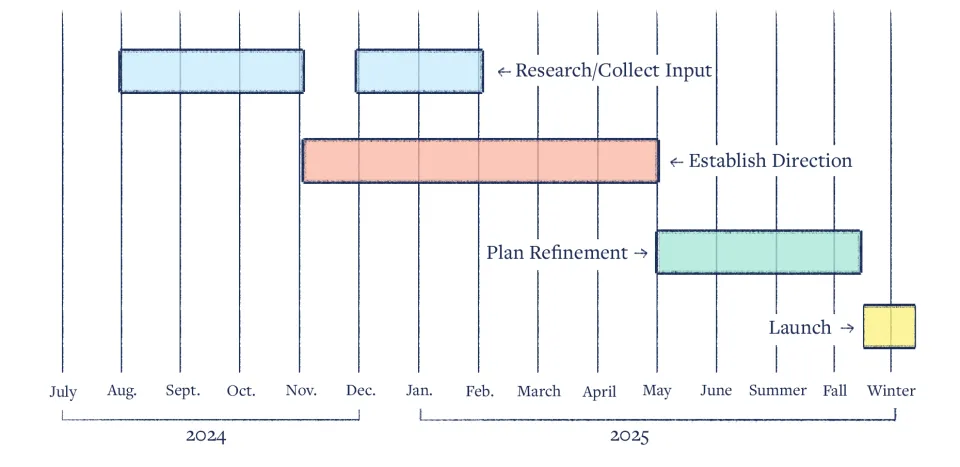Strategic Planning
Strategic Plan Development
How do you reach your goals? Make a plan! We’re currently in the refinement phase of developing Smith’s strategic plan, allowing us to outline actionable goals for the college.
In fall 2024, a Strategic Planning Steering Committee—composed of trustees, faculty, staff, students, and alums, and assisted by Wellspring Consulting—began the process of developing Smith’s strategic plan. In addition to the committee, the entire Smith community is actively participating throughout the process, providing input and feedback through group meetings, formal working groups, surveys, and community feedback sessions. Below you will find more information about the process and how you can be involved.
President and President’s Team members
- Sarah Willie-LeBreton, President
- Joanna Olin, Vice President for Government Relations and Chief of Staff
- David DeSwert, Executive Vice President for Finance and Administration
- Daphne Lamothe, Provost and Dean of the Faculty and Professor of Africana Studies
- Elena Palladino, Secretary to the Board of Trustees and AVP for Strategic Initiatives
Smith College Board of Trustees members
- Johan Aurik ’86, Board of Trustees member
- Claudia San Pedro ’91, Board of Trustees member, Vice Chair of Resources & Operations Committee
Current staff member
- ej seibert ’08, Dean of Student Affairs, Director of Care & Community Standards
Current faculty
- Nathan Derr, former Chair of Faculty Council, Associate Professor in the Department of Biological Sciences, Chair of the Program in Biochemistry, Director of the Center for Microscopy and Imaging
- Payal Banerjee, Associate Professor of Sociology
Academic Exploration
- Daphne Lamothe, Provost and Dean of the Faculty and Professor of Africana Studies
- Jennifer Joyce, Dean of the First-Year Class
- Terry-Ann Craigie, Associate Professor of Economics
- Becca Thomases, Professor of Mathematical Sciences
- Janelle Bradshaw, Trustee
- Minh Ly, Associate Director for Assessment, Institutional Research
- Margot Audero ’26, Engineering major
- Dawn Fulton, Professor of French Studies
Leadership & Career
- Denise McKahn, Associate Provost
- Faith McClellan, Dean of Career Development, Lazarus Center
- Fraser Stables, Associate Dean for Integrative Learning, Professor of Art
- Erin Cohn ’00, Director, Wurtele Center for Collaborative Leadership
- Christie Kennedy ’10, Director of Alumnae Leadership and Career Engagement
- Ann Silverman, Trustee
- Bozena “Boz” Welborne, Associate Professor and Chair of Middle East Studies, Associate Professor of Government
Community
- ej seibert ’08, Dean of Student Affairs, Director of Care & Community Standards
- Samantha Earp, former Vice President of Information Technology and Chief Information Officer
- Chiderah Emeakoroha ’27, Government major
- Chris Aiken, Professor of Dance
- Bill Peterson, Professor of Psychology
- Liz Klarich, Associate Professor of Anthropology
- Cecilia Edwards ’88, Trustee
Goals
The four goals of Smith’s Compass 2035 plan are to:
Drafts of Key Initiatives
The strength of Smith’s strategic plan rests in the powerful connections among the initiatives that advance our four foundational goals. Each initiative amplifies the others, weaving together a vision of the college that is bold, purposeful, and enduring. Smith will:
- Ensure financial accessibility for every admitted undergraduate student
- Expand student supports for exploration and discovery across all four years
- Ensure faculty lead in connecting research, teaching, and curricular innovation
- Cultivate strategic partnerships to expand Smith’s reach
- Foster well-being, connection, and joy in campus spaces for all
- Embrace transformative inclusion in our community
- Investigate and apply emerging technologies with discernment, humanity and integrity
- Secure Smith's future as a perpetual institution
Thank you for all your input!
We are deeply appreciative to the over 4,000 individuals who have provided input. The researching/collecting input and establishing direction stages have concluded. The process has moved into its final refinement stage. However, we continue to welcome your feedback via email at suggestionbox@smith.edu.
Timeline & More Information

Letters from President Sarah
- Strategic Planning Kickoff, September 3, 2024
- Strategic Planning Update, December 16, 2024
- Update on Strategic Planning, March 14, 2025
- Update on Strategic Planning, August 27, 2025
- Strategic Planning Update, November 12, 2025
Research/Collect Input
- Conduct baseline research on Smith College through a review of internal data and an initial set of 1:1 interviews with certain community members, including members of the Strategic Planning Steering Committee
- Engage in a round of internal listening with 100–175 people, including three days of engagement opportunities on campus
- Conduct an analysis of the higher education landscape, learning from analogous organizations and benchmarking Smith against similar colleges
Establish Direction
Prepare for Implementation
Last updated: August 25, 2025
I understand Smith is engaged in a strategic planning process. What is a strategic plan?
A strategic plan is an organization’s road map for the future. It typically includes several high-level goals, as well as objectives and/or initiatives within each of those goals, that an organization seeks to achieve in a defined time frame. Engaging in a strategic planning process offers an institution like Smith a moment to pause and consider how it can best achieve its mission in the coming years, and what changes may be necessary in order to lay the groundwork for continued success. It also offers community members an opportunity to participate in shaping the future of the college.
I’ve heard that Smith is also starting a comprehensive campus use planning process. What is that and how is it different from strategic planning?
Smith has engaged Sasaki, an interdisciplinary architecture, planning, landscape, and design firm to help the college consider its current and future needs related to physical space on campus. The campus use plan will provide a framework for the development of the built environment at Smith, including infrastructure, facilities and land use, to support and enable the strategic plan goals. Learn more about Sasaki’s work with Smith.
How will these processes work together, and what benefit is there to undertaking both processes simultaneously?
The campus use planning team is coordinating with and will draw from our ongoing strategic planning efforts to ensure a close alignment between the college’s mission and strategic priorities and the use and experience of space on campus. Our partners at Wellspring and Sasaki are collaboratively sharing data and insights on developing priorities and will continue to coordinate on updates and community-wide feedback forums as both plans progress. We are delighted to undertake these two processes simultaneously, which will allow us to avoid duplication of efforts and ensure both plans are designed to support and enhance one another.
How did we get from strategic goals to objectives?
Since February, we have been focused on building out objectives and initiatives to support each of these strategic goals. To guide the creation of objectives and initiatives, the Steering Committee and the President’s Team developed a set of key questions within each goal. Various Smith-led groups, including working groups of faculty, staff, students, and alums, as well as relevant faculty and staff leaders, have been grappling with these key questions and developing objectives and initiatives to respond to each. Working groups focused on those key questions that cut across the entire college and would most benefit from cross-constituency engagement.
Goal 1: Inspire and support academic excellence, exploration, and discovery
Key questions:
- How will we encourage and support students to receive the full benefits of Smith College’s liberal arts education by embracing academic exploration?
- How will we ensure that Smith remains on the forefront of academic scholarship and pedagogy?
- How will we invest in emergent areas of inquiry and pedagogy and respond to shifts in student interest?
- How will we expand support for student mentorship and research that directly enhance the academic experience?
Goal 2: Prepare students for fulfilling careers and a lifetime of leadership
Key questions:
- How will we support students to take advantage of opportunities for leadership and career development, and connect these opportunities with the curriculum?
- How will we provide more accessible opportunities for alums and students to support the college community, including volunteering and giving options?
- How will we more effectively partner with alums to advance the career growth of its students and recent graduates, and deepen alums’ connection to the college?
Goal 3: Foster wellbeing, belonging, and resilience across our community
Key questions:
- How will we reimagine our traditions, structures, practices, and rituals to promote a sense of belonging for everyone in our increasingly diverse community?
- How will we promote balance and focus through standards and norms across staff, faculty, and students?
- How will we evaluate and prioritize mental health and accessibility support to respond to the highest areas of demand?
- How could current physical spaces be reimagined to foster regular positive interactions among staff, faculty, and students?
Goal 4: Strengthen institutional sustainability to ensure the college’s enduring contributions to the world
Key questions:
- How can we collectively foster a culture of ethical and courageous discernment that allows us to lay down and consolidate work when we can, and invest our limited energy and resources in our highest priorities?
- How can we balance our commitment to financial accessibility for students in the context of future financial challenges?
- How will we advance our commitment to act against climate change including and beyond near elimination of fossil fuel utilization on our campus?
- How will we sustain our workforce and promote employee engagement in light of increased labor market competition, the shifting nature of work, and other external forces?
- How will we continue to leverage technology, including AI, to support strategy?
Who from Smith is leading the strategic planning process?
The process is being led by Smith’s Strategic Planning Steering Committee. Three working groups made up of faculty, staff, students, and alums are also supporting the development of specific areas of the plan.
What data has informed the strategic planning process?
We are more than halfway through the development of the strategic plan. To date, the Strategic Planning Steering Committee (“Steering Committee”) has considered findings collected from myriad sources, including conversations with hundreds of Smith community members, internal surveys and reports, department and center annual reports and strategic plans, peer college benchmarking data, and interviews with leaders of other colleges and universities. In January, over 4,000 faculty, staff, students, and alums participated in a community survey, which served as another input to the process. The following groups were engaged in specific discussions related to strategic planning:
- Faculty Council
- Academic Chairs
- Alumnae Association Board
- Committee on Mission and Priorities
- Senior staff
- Staff Council
- House Presidents Association
- Student Government Association Cabinet
- Board of Trustees
- Dean’s Advisory Council
- Inclusion Council
- Committee on Sustainability
- Sherrerd Center Advisory Board
- Science Center Committee on Diversity
- Residential Life
What opportunities do I have to make my voice heard in the strategic planning process?
We are grateful to the thousands of Smith community members who have already participated in this process and welcome your continued participation moving forward. Here are some upcoming ways to provide input to the plan:
- Share your thoughts with a member of the Steering Committee or working groups
- Email your thoughts to suggestionbox@smith.edu or to AVP for Strategic Initiatives Elena Palladino at epalladino@smith.edu.
When will the strategic plan be launched?
We finalized draft initiative development in early-April. In April and May, the Steering Committee, working group co-chairs, and other college leaders began building out draft plans for implementation—determining who will do what, by when—in order to accomplish our goals over the next decade. Wellspring supported our team in those efforts through May. Over the summer, Smith will continue to refine the plan. The Board of Trustees will meet in December to endorse the final strategic plan.
Happening Now
December
- Strategic Planning Steering Committee meeting
- Present plan to the Board of Trustees




